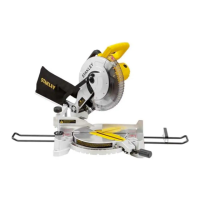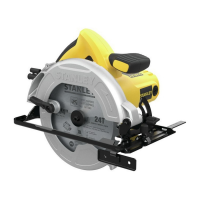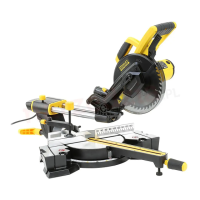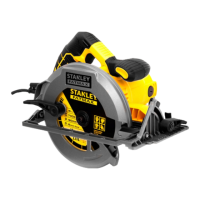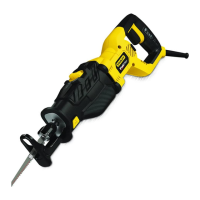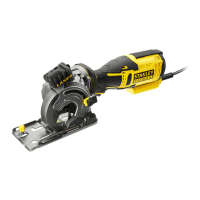- Turn anti-clockwise; to increase the cutting depth
- Turn Clockwise; to reduce the cutting depth
After each new adjustment it is advisable to carry out a trial
cut in order to check the set dimensions.
Setting the angle (Fig J)
Set the required bevel angle from 0 to 45 degree Before
cutting, ensure the saw blade (4) and mitre gauge (6) no
collision
- Loose the Bevel adjustment locking knob (10).
- Set up the desired angle then lock the knob again.
Narrow material fence mounting (Fig K)
- The Narrow Material Fence (i) of the rip fence (5) has two
guiding surface with different heights.
- Depending on the thickness of the material to be cut, the
higher side of the Narrow Material Fence (i) has to be
used for thick material (work piece thickness above
25mm) and the lower side of the fence rail for thin
material (work piece thickness below 25mm).
- For the adjustment, loosen the bolts on the side of the rip
fence (5) and push the Narrow Material Fence (i) on the
guide, depending on the required position.
- Tighten the bolts again.
Setting the cutting width (Fig. M)
- The rip fence (5) is used for lengthwise cutting of wood.
- Place the rip fence (5) on the guide rail (18) to the right or
left of the saw blade.
- 2 scales (k/l) on the guide rail (18) to show the gap
between fence rail and saw blade (4)
When the cutting width less than 300mm, means table no
extended, refer to scale (k). The red mark of sight-glass (m)
shows the required cutting width setup;
When cutting width more than 300mm need table extended,
refer to scale (l). Ensure the red mark of sight-glass (m) at
300mm and lock the rip fence, then the pointer (aa) aim at
scale (l) value shows the required cutting width setup.
Extension table (Fig N)
- The extension table (16) could be used for particularly
wide workpieces.
- Loosen the locking handle (14) and pull out the table width
extension.
- Turn anti-clockwise; to increase the cutting depth
- Turn Clockwise; to reduce the cutting depth
After each new adjustment it is advisable to carry out a trial
cut in order to check the set dimensions.
Setting the angle (Fig J)
Set the required bevel angle from 0 to 45 degree Before cutting,
ensure the saw blade (4) and mitre gauge (6) no collision
- Loose the Bevel adjustment locking knob (10).
- Set up the desired angle then lock the knob again.
Narrow material fence mounting (Fig K)
- The Narrow Material Fence (i) of the rip fence (5) has two
guiding surface with different heights.
- Depending on the thickness of the material to be cut, the
higher side of the Narrow Material Fence (i) has to be
used for thick material (work piece thickness above 25mm)
and the lower side of the fence rail for thin material (work
piece thickness below 25mm).
- For the adjustment, loosen the bolts on the side of the rip
fence (5) and push the Narrow Material Fence (i) on the
guide, depending on the required position.
- Tighten the bolts again.
Rip fence mounting (Fig L)
- Fix the rip fence (5) at the back side and press the locking
handle (15) downwards.
- When disassembling, pull the locking handle up and
remove the rip fence (5).
- The rip fence could be locked setting with the rear knurled
nut.
i5
K
Rip fence mounting (Fig L)
- Fix the rip fence (5) at the back side and press the locking
handle (15) downwards.
- When disassembling, pull the locking handle up and
remove the rip fence (5).
-
The rip fence could be locked setting with the rear knurled nut.
Setting the cutting width (Fig. M)
- The rip fence (5) is used for lengthwise cutting of wood.
- Place the rip fence (5) on the guide rail (18) to the right or
left of the saw blade.
- 2 scales (k/l) on the guide rail (18) to show the gap
between fence rail and saw blade (4)
When the cutting width less than 300mm, means table no
extended, refer to scale (k). The red mark of sight-glass (m)
shows the required cutting width setup;
When cutting width more than 300mm need table extended,
refer to scale (l). Ensure the red mark of sight-glass (m) at
300mm and lock the rip fence, then the pointer (aa) aim at
scale (l) value shows the required cutting width setup.
Extension table (Fig N)
- The extension table (16) could be used for particularly
wide workpieces.
- Loosen the locking handle (14) and pull out the table width
extension.
- Turn anti-clockwise; to increase the cutting depth
- Turn Clockwise; to reduce the cutting depth
After each new adjustment it is advisable to carry out a trial
cut in order to check the set dimensions.
Setting the angle (Fig J)
Set the required bevel angle from 0 to 45 degree Before cutting,
ensure the saw blade (4) and mitre gauge (6) no collision
- Loose the Bevel adjustment locking knob (10).
- Set up the desired angle then lock the knob again.
Narrow material fence mounting (Fig K)
- The Narrow Material Fence (i) of the rip fence (5) has two
guiding surface with different heights.
- Depending on the thickness of the material to be cut, the
higher side of the Narrow Material Fence (i) has to be
used for thick material (work piece thickness above 25mm)
and the lower side of the fence rail for thin material (work
piece thickness below 25mm).
- For the adjustment, loosen the bolts on the side of the rip
fence (5) and push the Narrow Material Fence (i) on the
guide, depending on the required position.
- Tighten the bolts again.
Rip fence mounting (Fig L)
- Fix the rip fence (5) at the back side and press the locking
handle (15) downwards.
- When disassembling, pull the locking handle up and
remove the rip fence (5).
- The rip fence could be locked setting with the rear knurled
nut.
i5
K
515
L
Setting the cutting width (Fig. M)
- The rip fence (5) is used for lengthwise cutting of wood.
- Place the rip fence (5) on the guide rail (18) to the right or
left of the saw blade.
- 2 scales (k/l) on the guide rail (18) to show the gap
between fence rail and saw blade (4)
When the cutting width less than 300mm, means table no
extended, refer to scale (k). The red mark of sight-glass (m)
shows the required cutting width setup;
When cutting width more than 300mm need table extended,
refer to scale (l). Ensure the red mark of sight-glass (m) at
300mm and lock the rip fence, then the pointer (aa) aim at
scale (l) value shows the required cutting width setup.
Setting the cutting width (Fig. M)
- The rip fence (5) is used for lengthwise cutting of wood.
- Place the rip fence (5) on the guide rail (18) to the right or
left of the saw blade.
- 2 scales (k/l) on the guide rail (18) to show the gap
between fence rail and saw blade (4)
When the cutting width less than 300mm, means table no
extended, refer to scale (k). The red mark of sight-glass (m)
shows the required cutting width setup;
When cutting width more than 300mm need table extended,
refer to scale (l). Ensure the red mark of sight-glass (m) at
300mm and lock the rip fence, then the pointer (aa) aim at
scale (l) value shows the required cutting width setup.
Extension table (Fig N)
- The extension table (16) could be used for particularly
wide workpieces.
- Loosen the locking handle (14) and pull out the table width
extension.
- Turn anti-clockwise; to increase the cutting depth
- Turn Clockwise; to reduce the cutting depth
After each new adjustment it is advisable to carry out a trial
cut in order to check the set dimensions.
Setting the angle (Fig J)
Set the required bevel angle from 0 to 45 degree Before cutting,
ensure the saw blade (4) and mitre gauge (6) no collision
- Loose the Bevel adjustment locking knob (10).
- Set up the desired angle then lock the knob again.
Narrow material fence mounting (Fig K)
- The Narrow Material Fence (i) of the rip fence (5) has two
guiding surface with different heights.
- Depending on the thickness of the material to be cut, the
higher side of the Narrow Material Fence (i) has to be
used for thick material (work piece thickness above 25mm)
and the lower side of the fence rail for thin material (work
piece thickness below 25mm).
- For the adjustment, loosen the bolts on the side of the rip
fence (5) and push the Narrow Material Fence (i) on the
guide, depending on the required position.
- Tighten the bolts again.
Rip fence mounting (Fig L)
- Fix the rip fence (5) at the back side and press the locking
handle (15) downwards.
- When disassembling, pull the locking handle up and
remove the rip fence (5).
- The rip fence could be locked setting with the rear knurled
nut.
i5
K
515
L
N
14 16
M
5
18 k l
aa
m
Extension table (Fig N)
- The extension table (16) could be used for particularly
wide workpieces.
- Loosen the locking handle (14) and pull out the table
width extension.
Setting the cutting width (Fig. M)
- The rip fence (5) is used for lengthwise cutting of wood.
- Place the rip fence (5) on the guide rail (18) to the right or
left of the saw blade.
- 2 scales (k/l) on the guide rail (18) to show the gap
between fence rail and saw blade (4)
When the cutting width less than 300mm, means table no
extended, refer to scale (k). The red mark of sight-glass (m)
shows the required cutting width setup;
When cutting width more than 300mm need table extended,
refer to scale (l). Ensure the red mark of sight-glass (m) at
300mm and lock the rip fence, then the pointer (aa) aim at
scale (l) value shows the required cutting width setup.
Extension table (Fig N)
- The extension table (16) could be used for particularly
wide workpieces.
- Loosen the locking handle (14) and pull out the table width
extension.
- Turn anti-clockwise; to increase the cutting depth
- Turn Clockwise; to reduce the cutting depth
After each new adjustment it is advisable to carry out a trial
cut in order to check the set dimensions.
Setting the angle (Fig J)
Set the required bevel angle from 0 to 45 degree Before cutting,
ensure the saw blade (4) and mitre gauge (6) no collision
- Loose the Bevel adjustment locking knob (10).
- Set up the desired angle then lock the knob again.
Narrow material fence mounting (Fig K)
- The Narrow Material Fence (i) of the rip fence (5) has two
guiding surface with different heights.
- Depending on the thickness of the material to be cut, the
higher side of the Narrow Material Fence (i) has to be
used for thick material (work piece thickness above 25mm)
and the lower side of the fence rail for thin material (work
piece thickness below 25mm).
- For the adjustment, loosen the bolts on the side of the rip
fence (5) and push the Narrow Material Fence (i) on the
guide, depending on the required position.
- Tighten the bolts again.
Rip fence mounting (Fig L)
- Fix the rip fence (5) at the back side and press the locking
handle (15) downwards.
- When disassembling, pull the locking handle up and
remove the rip fence (5).
- The rip fence could be locked setting with the rear knurled
nut.
i5
K
515
L
N
14 16
11
ENGLISH

